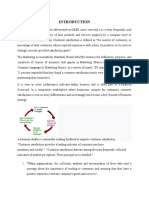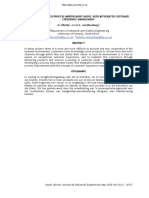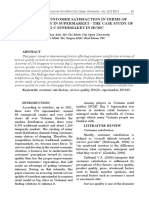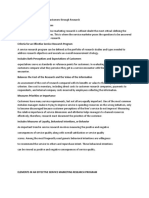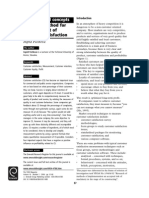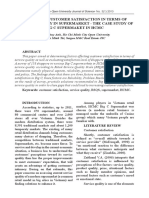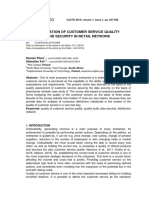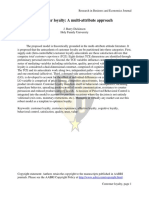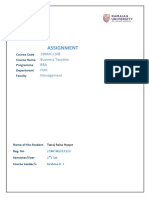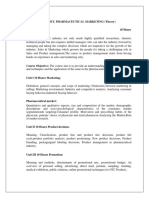An Approach For Customer Satisfaction Measurement Based On Artificial Neural Networks
An Approach For Customer Satisfaction Measurement Based On Artificial Neural Networks
Uploaded by
abdullahcsjmiCopyright:
Available Formats
An Approach For Customer Satisfaction Measurement Based On Artificial Neural Networks
An Approach For Customer Satisfaction Measurement Based On Artificial Neural Networks
Uploaded by
abdullahcsjmiOriginal Title
Copyright
Available Formats
Share this document
Did you find this document useful?
Is this content inappropriate?
Copyright:
Available Formats
An Approach For Customer Satisfaction Measurement Based On Artificial Neural Networks
An Approach For Customer Satisfaction Measurement Based On Artificial Neural Networks
Uploaded by
abdullahcsjmiCopyright:
Available Formats
2524The Sixth Wuhan International Conference on E-Business Innovation Management Track
An Approach for Customer Satisfaction Measurement Based on Artificial
Neural Networks
Wenbo Li
1
, Changjiang Li
2
1
School of Business Administration, Zhejiang Gongshang University, Hangzhou, 310018, China
sxylwb@zjnu.cn
2
School of Business Administration, Zhejiang Normal University, Jinhua, 321004, China
Abstract: The linkage of customer satisfaction and firm profitability has been well established in the marketing literature,
and provides ample justification as to why customer satisfaction measurement (CSM) has been a focal point in marketing
decision making. However, customer satisfaction is a subjective concept and hard to measure. Therefore, there are very few
papers studying this customer satisfaction measurement problem. The artificial neural networksANNis a technique that is
studied heavily and used in applications for engineering and scientific fields for various purposes. In this paper, we propose
an approach for the customer satisfaction measurement based on artificial neural networks. The paper is organized as follows.
The first section is introduction. The second section constructs the index system of customer satisfaction measurement. The
third section is the basic model. The fourth section, using survey data on some customers, an example is given and the results
demonstrate that the method performs very well. Last, it contains some conclusions.
Keywords: customer satisfaction measurement, artificial neural networks, index system
1.INTRODUCTION
As the competition in the marketplace continues to grow, understanding customer has become an important
method of marketing. According to the Chartered Institute of Marketing, marketing can be defined as: The
management process for identifying, anticipating and satisfying customer requirements profitably. This means
todays companies have moved from product and sales philosophy to a new marketing philosophy.
Customer-centered companies have emphasized a better understanding of customers needs and wants, and then
translated them into the capability to give customers what they really need and want. Simply stated, customer
satisfaction is essential for corporate survival. Several studies have found that it costs about five times as much
in time, money and resources to attract a new customer as it does to retain an existing customer
[1]
. The rewards
to firms that establish a loyal customer base have been well documented
[2,3]
. Social psychologists, marketing
researchers, and students of consumer behavior, have extensively studied the concepts of customer satisfaction
and dissatisfaction. The result of all this research has been the development of nine distinct theories of customer
satisfaction. The nine theories include: expectancy disconfirmation; assimilation or cognitive dissonance;
contrast; assimilation-contrast; equity; attribution; comparison-level; generalized negativity and value-precept
[4]
.
Based on the present literature, customer satisfaction is defined as the result of a cognitive and affective
evaluation, where some comparison standard is compared to the actually perceived performance. If the
perceived performance is less than expected, customers will be dissatisfied. On the other hand, if the perceived
performance exceeds expectations, customers will be satisfied. Otherwise, if the perceived expectations are met
with performance, customers are in an indifferent or neural stage. In general, increased customer satisfaction
leads to higher customer retention rate, increases customer repurchase behavior, and ultimately drives higher
The Sixth Wuhan International Conference on E-Business Innovation Management Track2525
firm profitability
[5]
. That is, the linkage of customer satisfaction and firm profitability has been well established
through earlier research. However, customer satisfaction is a subjective concept and is hard to measure.
Therefore, this is one of the topics deserving more researches in the future study of decision analysis and
decision support. With this in mind, this main purpose of this paper is to propose an approach for customer
satisfaction measurement. To be successful, a customer satisfaction measurement program must come from and
be incorporated into the firms corporate culture. In todays competitive environment one of the most important
goals of corporate culture is retaining and satisfying current and past customers.
The artificial neural networks is a technique that is studied heavily and used in applications for engineering
and scientific fields for various purposes ranging from control systems to urban planning. Its generalization
powers have not only received admiration from the engineering and scientific fields, but in recent years, many
researchers are taking an interest in the application of management fields. A neural network has a massively
parallel and distributed structure, which is composed of many simple processing elements (i.e., artificial neurons)
with nonlinear mapping functions. The neurons in a neural network can communicate to each other through the
links (i.e., weights) between the neurons. This application solves the non-linearity, which is cumbersome when
used in the traditional manner. It overcomes difficulties such as lacking self-adaptation, low efficiency and
effectiveness. Thus, it lays the foundation of a practical application for customer satisfaction measurement.
The remainder of the paper is organized as follows. First, it constructs the index system of customer
satisfaction measurement. Second, it introduces the general model. Third, using survey data on some customers,
an instance analysis is given to show that this method is feasible in reality. And last, it contains some simple
conclusions.
2. BUILD CUSTOMER SATISFACTION MEASUREMENT INDEX SYSTEM
Measure customer satisfaction has become increasingly popular in the last two decades the satisfaction
construct has gained an important role in the marketing literature. In order to measure the customer satisfaction,
first, we must build the index system; then, we can choose the suitable approach. It is well known that customer
satisfaction measurement is a complex system made of elementary units interacting with different laws. In other
words, improving the customer satisfaction can come from a variety of activities available to the firm.
Customer satisfaction is measured in two ways. The first measure consists of responses to a single question
on the customer-satisfaction questionnaire: Overall, how satisfied are you with(the supermarket)? Response
for all satisfaction questions are made on 1-7Likert-type scales labeled very satisfied (1) and very dissatisfied
(7) at each extreme. The second indicator of customer satisfaction, satisfaction with service and satisfaction
with price (measured independently as the service index and the price index) is developed from theories
found in the service management literature
[6,7]
. Simplified, these theories state that perceived value is a function
of perceived quality and price, and that differing levels of perceived value result in differing levels of customer
satisfaction.
The existing evidence suggests that customer satisfaction is likely to come from improvements in service
quality, service features and customer complaint handling.
(1) Service quality. Not surprising, there are strong linkages between service quality dimensions (e.g.
courteous service providers) and overall customer satisfaction
[8]
. However, little empirical research has
examined the importance of service quality dimensions in determining customer satisfaction
[9]
. Extensive
research has been conducted on developing and measuring service quality
[10,11]
. Empirical evidence and
theoretical arguments suggest that there may be two overriding dimensions to service quality: the core or
outcome aspects (contractual) of the service, and the relational or process aspects (customer employee
relationship) of the service
[12]
.
2526The Sixth Wuhan International Conference on E-Business Innovation Management Track
(2) Service features. Customer satisfaction is also related to the service offering. Research has shown that
customer satisfaction is likely to come from improvements in service features.
(3) Customer complaint handling. A major reason why customers switch service providers is unsatisfactory
problem resolution
[13]
. When customers face a problem, they may respond by existing (switching to a new
supplier), voicing (attempting to remedy the problem by complaining) or loyalty (staying with the supplier,
anticipating that things will get better.)
[14]
.
In this paper, we give an example through the survey data in a supermarket. With the supermarket, the
convenience and competitiveness of the providers offering can be expected to affect a customers overall
satisfaction and ongoing patronage. And, location is also a major determinant of customer choice. Through
analyzing the behavior of loyal customers, we establish the customer satisfaction measurement index system
consisting of geographic position, the variety of goods price, the overall price level, the overall quality of goods,
the time of waiting for payment, service attitude and shopping environment.
3. THE THREE-LAYER BP MODEL
The 3-layer model is the most widely studied and applied model in artificial neural networks
[15,16]
. Figure 1
shows the architecture of 3-layer model, which is composed of an input layer, a middle (hidden) layer, and an
output layer. The middle layer is at the midst of the input layer and is seen as an internal representation of the
input pattern. It is at this layer that patterns are identified from the distilling the characteristics of the input and
are then sent to the output layer. The result of the output layer is a judgment on the classification of the input
patterns. So the middle layer can be called the distilling character layer. Now, we first clarify the input and
output variables. The input variables concludes: customer satisfaction factors were entered into the network:
geographic position, the variety of goods price, the overall price level, the overall quality of goods, the time of
waiting for payment, service attitude and shopping environment. The output variable is only one possible
measurement value.
Output
Output
layer
Hidden
layer
Input
layer
I1
I2
In
x1
x2
xn
Input
( )
i j ij
x w n o - =
(neural activation function)
Output
Transfer function
w1
w2
wj
( ) ( ) ( )
1
1
+ = x e x f
...
Figure 1. Example of an artificial neural network Figure 2. An artificial neural network
In this study, a supervised learning paradigm has been chosen with a multi-layer feed-forward architecture.
The back- propagation has been selected as the learning algorithm. The fundamental mechanism of
back-propagation is to propagate input values in a feed-forward manner through hidden layers of a network to
the output layer, and then to propagate errors back from the output layer to an input layer. The functioning of the
neurons in such a network is illustrated in Figure 2, and this shows a basic back-propagation neuron receiving N
inputs ( )
n
x x x , , ,
2 1
" . Each of these inputs has an assigned weight factor w. The neuron calculates the sum
of weighted inputs and bias (or internal effects) and produces an output n given by the following equation:
( )
i j ij
x w n o - =
The Sixth Wuhan International Conference on E-Business Innovation Management Track2527
For all 1 2 j , ,..., N = , where
ij
w is the weight from node j to node i ,
j
x is the output value of node j ,
and
i
o is the node threshold value (also called bias, or internal offset). This value n then forms the input to a
transfer function within the neuron, which then produces an output to be processed by another layer of neurons
or signaled as a final output. An example of a transfer function is the standard sigmoid logistic non-linear
function ( ) x f , given by the following equation, which generates outputs between 0 and 1 for a range of
neuron inputs between ~ to ~ + , where is a slope parameter.
( ) ( ) ( )
1
1
+ = x e x f
4. INSTANCE ANALYSIS
As mentioned earlier, artificial neural networks are data-driven models. This means that artificial neural
networks are assumption-free approaches for estimating functions from sample data. To build an artificial neural
network model, one typically needs training and a test sample. The training sample is used to determine the
weights and parameters that define the artificial neural network model. The test sample is adopted for evaluate
the model. The training of neural networks can be classified into three categories: supervised; graded
(reinforcement) and unsupervised (self-organization)
[17]
. The set of input layer neurons are selected based on the
status information parameters. In this problem, the total number of input layer is equal to seven. The number of
neurons required in the hidden layer depends on the number of input parameters and the estimate of the number
of training data provided for training. The number of output layer neurons depends on the possible output values.
In this problem, there is one possible output value. Therefore one output neuron is sufficient to represent the
same.
For the purpose of our research, we select 30 customers of 10 supermarkets. Seven input parameters
consisting of customer satisfaction factors were entered into the network: geographic position, the variety of
goods price, the overall price level, the overall quality of goods, the time of waiting for payment, service attitude
and shopping environment. The hidden layer consisted of nine neurons and the output layer contained one
neuron for the measurement of customer satisfaction. The training sample is the former 25 data and the last five
is used to test its accuracy. A learning rate of 0.2 was specified and all connection weights and thresholds were
initialized to random values in the range of 0.1 to +0.1. As shown in Table 1, the ANN-based method is not
only effective but also feasible. A common PC ran the 1970 training trails with an error less than 0.005. The
following Figure 3 is the training phase error trend. The system was implemented with Matlab6.0.
Table 1. The testing results and relative error
No. Experts evaluation Testing results Relative error
1 0.461 0.451 0.022
2 0.639 0.594 0.070
3 0.683 0.699 0.023
4 0.661 0.662 0.002
5 0.559 0.561 0.004
Figure 3. The training phase error trend
5. CONCLUSIONS
Customer satisfaction measurement is important in a market driven economy and customer satisfaction
measurement decision-making relies on our understanding of customer satisfaction, its determinants, and their
2528The Sixth Wuhan International Conference on E-Business Innovation Management Track
relationship. The research contributes to the customer satisfaction measurement literature in several important
ways. First, this paper provides a good tool to support the customer satisfaction measurement, and the theory
analysis and simulation both shows that this method based on artificial neural networks performs very well.
Second, the market segments derived from our model are useful in aiding customer satisfaction measurement.
The result of customer satisfaction measurement provides significant information for modern management
process and a warning signal about future business results. Finally, the effect of neural networks architecture,
network training algorithm and learning paradigm need to be further examined or perhaps optimized to provide
a better results on its capability of customer satisfaction measurement. As the research of the project goes further,
more articles will follow up.
ACKNOWLEDGEMENT
The author acknowledges the contributions of LI Xiang-rong, DENG Shao-jun and CHEN Ji in the
collection of data.
REFERENCES
[1] Naumann, E.(1995). Customer Satisfaction Measurement and Management: Using the Voice of the Customer, Thomson
Executive Press, Cincinnati, OH.
[2] Armstrong, L. & Symonds, W.C. (1991). Beyond May I Help You?, Business Week, Special Issue, pp. 100-102.
[3] Reichheld, F.F. & Sasser, W.E.Jr (1990). Zero Defections: Quality Comes to Service. Harvard Business Review,
Vol.68,No.5, pp.105-112.
[4] Oh, H. and Parks, S.C.(1997). Customer Satisfaction and Service Quality: a Critical Review of the Literature and
Research Implications for the Hospitality Industry, Hospitality Research Journal, Vol. 20 No. 3, pp.36-65.
[5] Mittal, V., & Kamakura, W.A.(2001). Satisfaction, Repurchase Intent, and Repurchase Behavior: Investigating the
Moderating Effect of Customer Characteristics, Journal of Marketing Research, XXXVIII, 131-142.
[6] Heskett, J.L., Jones, T.O., Loveman, G.W., Sasser, W.E.Jr and Schlesinger, L.A.(1994). Putting the Service Profit Chain
to Work, Harvard Business Review. March-April, pp. 105-110.
[7] Schneider, B. and Browen, D.E.(1995), Winning the Service Game, HBS Press, Boston, MA.
[8] Anderson, E.A. & Sullivan, M.W. (1993). The Antecedents and Consequences of Customer Satisfaction for Firms,
Marketing Science, Vol.12, Spring, pp.125-150.
[9] Fisk, R.P., Brown, S.W. & Bitner, M.J.(1993), Tracking the evolution of the services marketing literature, Journal of
Retailing, Vol.69, Spring, pp.61-103.
[10] Brown, T.J., Churchill, G.A. Jr and Peter, J.P.(1993), Improving the Measurement of Service Quality, Journal of
Retailing, Vol.69, Spring, pp.127-135.
[11] Teas, R.K.(1993), Expectations, Performance Evaluation, and Consumers Perceptions of Quality, Journal of Marketing,
Vol.57 No.4, pp.18-32.
[12] McDougall, G. and Levesque, T.(1994). A Revised View of Service Quality Dimensions: an Empirical Investigation.
Journal of Professional Services Marketing, Vol. 11 No.1, pp.189-210.
[13] Hart, C.W.L., Heskett, J.L. and Sasser, E.W.Jr (1990). The Profitable Art of Service Recovery, Harvard Business
Review, Vol.68 No. 4, pp.148-162.
[14] Hirschman, A.O. (1970). Exit, Voice and Loyalty, Harvard University Press, Cambridge, MA.
[15] R.P. Lippman (1987). An Introduction to Computing with Neural Nets, IEEE ASSP Mag, April, 4-22.
[16] Simon Haykin (1995). Neural Networks: A Comprehensive Foundation, Macmillan College Publishing Company, New
York.
[17] Hecht-Nielsen, R. (1990). Neurocomputing, Addison-Wesley Publishing Company, Inc, San Diego, CA.
You might also like
- Exercise 1.3 Abad Abegail D.Document5 pagesExercise 1.3 Abad Abegail D.Jaylebert Perez MoncatarNo ratings yet
- Projct On Consumer SatisfactionDocument33 pagesProjct On Consumer SatisfactionRejo Raju Mathew100% (2)
- Fan IndustryDocument54 pagesFan Industryshani2767% (3)
- Re-Export Scenario Full StepsDocument22 pagesRe-Export Scenario Full StepsAnkit SrivastavaNo ratings yet
- Revalida (Smart)Document16 pagesRevalida (Smart)Alvin AmilNo ratings yet
- A Study On The Customer Satisfaction of TheDocument44 pagesA Study On The Customer Satisfaction of TheMessiNo ratings yet
- Thesis Customer LoyaltyDocument5 pagesThesis Customer LoyaltyWhatIsTheBestPaperWritingServiceSingapore100% (2)
- Synopsis On E-PurchasingDocument4 pagesSynopsis On E-PurchasingSheetal JainNo ratings yet
- Nithin ProjectDocument33 pagesNithin ProjectMuhammed Althaf VK0% (1)
- Customer Satisfaction: (Type Text)Document18 pagesCustomer Satisfaction: (Type Text)Ragul.MNo ratings yet
- MR Gowtham Aashirwad Kumar - A Study On Customer SatisfactionDocument19 pagesMR Gowtham Aashirwad Kumar - A Study On Customer SatisfactionRohit KumarNo ratings yet
- Chapter 1 IntroductionDocument37 pagesChapter 1 IntroductionRagul.M86% (14)
- Research: Customer Satisfaction, ADocument13 pagesResearch: Customer Satisfaction, AAshish AhujaNo ratings yet
- Listening To Customer THR Research 17 JulDocument65 pagesListening To Customer THR Research 17 JulKazi Rabbi Al AzizNo ratings yet
- Customer Satisfaction Thesis PDFDocument5 pagesCustomer Satisfaction Thesis PDFPaySomeoneToWriteMyPaperSingapore100% (2)
- Customer SatisfactionDocument3 pagesCustomer Satisfactionmskr123No ratings yet
- Customer Feedback CBDocument50 pagesCustomer Feedback CBcityNo ratings yet
- Customers SatisfactionDocument15 pagesCustomers SatisfactionSalkam PradeepNo ratings yet
- ABSTARCTDocument16 pagesABSTARCTA.THOUFEQ MOHAMEDNo ratings yet
- Artigo 5 PDFDocument14 pagesArtigo 5 PDFAmauri OrnellasNo ratings yet
- Customer Satisfaction in Banking Sector Research ProposalDocument9 pagesCustomer Satisfaction in Banking Sector Research Proposalmasoom_soorat100% (3)
- Customer Satisfaction: Customer Satisfaction, A Business Term, Is A Measure of How Products andDocument17 pagesCustomer Satisfaction: Customer Satisfaction, A Business Term, Is A Measure of How Products andRagul.MNo ratings yet
- 22 Customer Satisfaction VodafoneDocument43 pages22 Customer Satisfaction VodafonerajNo ratings yet
- Thesis On Impact of Service Quality On Customer SatisfactionDocument4 pagesThesis On Impact of Service Quality On Customer Satisfactionbrookelordmanchester100% (1)
- Gaps Model in Commercial Real EstateDocument30 pagesGaps Model in Commercial Real EstateSiddharth Singh TomarNo ratings yet
- Literature Review: BasedDocument7 pagesLiterature Review: BasedsalmanNo ratings yet
- Harshita Project SynopsisDocument10 pagesHarshita Project SynopsisharshitaNo ratings yet
- E Business Customer ExpectationsDocument7 pagesE Business Customer ExpectationskalladyNo ratings yet
- e Business Customer ExpectationsDocument7 pagese Business Customer ExpectationsKartik MuppirisettyNo ratings yet
- Customer Satisfaction Survey On AirtelDocument58 pagesCustomer Satisfaction Survey On Airtelsai thesisNo ratings yet
- Enhancing Customer Satisfaction in Terms of Service Quality in Supermarket - The Case Study of Big C Supermaket in HCMCDocument12 pagesEnhancing Customer Satisfaction in Terms of Service Quality in Supermarket - The Case Study of Big C Supermaket in HCMCAmanda ReyesNo ratings yet
- Customer Satisfaction in HyundaiDocument81 pagesCustomer Satisfaction in Hyundainavdeep2309No ratings yet
- Dissertation Customer LoyaltyDocument7 pagesDissertation Customer LoyaltyBuyingCollegePapersUK100% (1)
- The Effect of Service QualityDocument5 pagesThe Effect of Service QualityInternational Journal of Innovative Science and Research TechnologyNo ratings yet
- Customer Satisfaction ThesisDocument5 pagesCustomer Satisfaction Thesisjadotuw1viv3100% (1)
- Review of Related LiteratureDocument11 pagesReview of Related LiteratureRo BinNo ratings yet
- CultfitDocument12 pagesCultfitKS SreeragNo ratings yet
- 1.1background of The StudyDocument12 pages1.1background of The StudyYared MekbibNo ratings yet
- The Customer Satisfaction Research of 7-ELEVEn StoresDocument10 pagesThe Customer Satisfaction Research of 7-ELEVEn StoresCông Minh A-jNo ratings yet
- AssignimentDocument4 pagesAssignimentDerejaw MelkamuNo ratings yet
- Impacts of Quality Service On Customer Loyalty. A Case Study of Banks in The UK Name: Course: DateDocument8 pagesImpacts of Quality Service On Customer Loyalty. A Case Study of Banks in The UK Name: Course: Datesamuel opiyoNo ratings yet
- The Effect of Customer Relationship Management (CRM) On Customer SatisfactionDocument72 pagesThe Effect of Customer Relationship Management (CRM) On Customer Satisfactionabubakar ibrahim100% (1)
- Effect of Customer Experience On Customer Satisfaction: Research ProposalDocument4 pagesEffect of Customer Experience On Customer Satisfaction: Research ProposalPriNcess AsmaNo ratings yet
- Chapter 6Document4 pagesChapter 6Private JzNo ratings yet
- Service Quality Management in Retailing: Theory and Empirical Analysis of Customer Satisfaction With Checkout ServicesDocument7 pagesService Quality Management in Retailing: Theory and Empirical Analysis of Customer Satisfaction With Checkout ServicesVasantha KumarNo ratings yet
- An IndexDocument10 pagesAn Indexroshan_khadka0075501No ratings yet
- The Effect of Retail Service Quality and Product Quality On Customer LoyaltyDocument20 pagesThe Effect of Retail Service Quality and Product Quality On Customer LoyaltyThomas T PaikadaNo ratings yet
- American Customer Satisfaction Model (ACSI Model)Document27 pagesAmerican Customer Satisfaction Model (ACSI Model)Hiep TrinhNo ratings yet
- Unit 9 - Customer SatisfactionDocument7 pagesUnit 9 - Customer SatisfactionMark Bacuel100% (1)
- Empirically Investigating The Integrating Effect of Customer Feedback and Customer Satisfaction On Customer Relationship ManagementDocument6 pagesEmpirically Investigating The Integrating Effect of Customer Feedback and Customer Satisfaction On Customer Relationship ManagementlakcitrusNo ratings yet
- 103 316 2 PBDocument12 pages103 316 2 PBMei YingNo ratings yet
- Evaluation of Customer Service QualDocument6 pagesEvaluation of Customer Service Qualcstubborn10No ratings yet
- Literature Review of Customer Satisfaction in HotelDocument6 pagesLiterature Review of Customer Satisfaction in Hotelc5eyjfntNo ratings yet
- Customer Satisfaction and Loyalty ThesisDocument6 pagesCustomer Satisfaction and Loyalty Thesisanaespinalpaterson100% (2)
- Thesis On Customer Satisfaction and Service QualityDocument5 pagesThesis On Customer Satisfaction and Service Qualitycynthiawilsonarlington100% (2)
- Customer Satisfaction in The Service Industry-Case Study of Telecommunication Industry in AlbaniaDocument8 pagesCustomer Satisfaction in The Service Industry-Case Study of Telecommunication Industry in AlbaniasravanthiNo ratings yet
- Customer Loyalty: A Multi-Attribute ApproachDocument17 pagesCustomer Loyalty: A Multi-Attribute ApproachTafakharNo ratings yet
- Customer Satisfaction, A: Business TermDocument4 pagesCustomer Satisfaction, A: Business TermDurga Prasad KNo ratings yet
- Measuring Consumer Satisfaction. Evidence From Romania: Florian Gyula LaszloDocument7 pagesMeasuring Consumer Satisfaction. Evidence From Romania: Florian Gyula LaszloMaria SaleemNo ratings yet
- Factors Influencing Customer SatisfactioDocument8 pagesFactors Influencing Customer SatisfactioashutoshNo ratings yet
- Relationship Between Service Quality and Customer Satisfaction ThesisDocument8 pagesRelationship Between Service Quality and Customer Satisfaction Thesislizaschmidnaperville100% (2)
- Measuring Customer Satisfaction: Exploring Customer Satisfaction’s Relationship with Purchase BehaviorFrom EverandMeasuring Customer Satisfaction: Exploring Customer Satisfaction’s Relationship with Purchase BehaviorRating: 4.5 out of 5 stars4.5/5 (6)
- Quality Experience Telemetry: How to Effectively Use Telemetry for Improved Customer SuccessFrom EverandQuality Experience Telemetry: How to Effectively Use Telemetry for Improved Customer SuccessNo ratings yet
- The Advertising IndustryDocument4 pagesThe Advertising Industrymartand86No ratings yet
- Chapter 07Document22 pagesChapter 07marieieiemNo ratings yet
- Executive SummaryDocument20 pagesExecutive SummaryMT RANo ratings yet
- DLCPM00312970000016079 2022Document2 pagesDLCPM00312970000016079 2022Anshul KatiyarNo ratings yet
- The Advertising Industry: by Akshay ShuklaDocument16 pagesThe Advertising Industry: by Akshay ShuklaAkshay ShuklaNo ratings yet
- Guide To The Letter of CreditDocument49 pagesGuide To The Letter of CreditSudershan ThaibaNo ratings yet
- Strategy Governance and Ethics Strathmore University Notes and Revision Kit PDFDocument404 pagesStrategy Governance and Ethics Strathmore University Notes and Revision Kit PDFmaxwell maingiNo ratings yet
- Wipro TechnologiesDocument18 pagesWipro TechnologiesSaswata BanerjeeNo ratings yet
- What Are Fringe BenefitsDocument4 pagesWhat Are Fringe BenefitsKeith SantiagoNo ratings yet
- Entrepreneurship Budget of WorkDocument3 pagesEntrepreneurship Budget of WorkRachel BandiolaNo ratings yet
- Role of Information Systems in Strategic Business Development in RMG IndustryDocument13 pagesRole of Information Systems in Strategic Business Development in RMG IndustrySangya SinghNo ratings yet
- Britannia Industries LTD Financial Model 1728973609Document18 pagesBritannia Industries LTD Financial Model 1728973609samal.arabinda25No ratings yet
- Accounting For Value (Penman) SP2016Document5 pagesAccounting For Value (Penman) SP2016darwin12No ratings yet
- Classification of CostsDocument28 pagesClassification of CostsDhanya Das100% (1)
- Session 1 - HSMDocument32 pagesSession 1 - HSMlaxman kavitkarNo ratings yet
- Customer Onboarding at ICICI Securities The Digital Marketing DilemmaDocument19 pagesCustomer Onboarding at ICICI Securities The Digital Marketing DilemmaShankaran RamanNo ratings yet
- A More Expensive Cuppa: Nestle (Malaysia)Document8 pagesA More Expensive Cuppa: Nestle (Malaysia)bijueNo ratings yet
- Payroll Accounting - 2024Document19 pagesPayroll Accounting - 2024angelbotshelo80No ratings yet
- Doing Business in Indonesia: A Short-Form Business ProfileDocument7 pagesDoing Business in Indonesia: A Short-Form Business ProfileAnimat_MeNo ratings yet
- Mba Project Report On Online Trading DerivativesDocument94 pagesMba Project Report On Online Trading DerivativesChakradhar Palagiri0% (1)
- Assignment: 19BMC110B Business Taxation BBA FMC ManagementDocument12 pagesAssignment: 19BMC110B Business Taxation BBA FMC Managementgirl on fireNo ratings yet
- The Logical Trader PDFDocument137 pagesThe Logical Trader PDFprabath_tooNo ratings yet
- 2-How To Become A World Class Project ManagerDocument9 pages2-How To Become A World Class Project ManagerAsjad Jamshed0% (1)
- Delloite Company ProfileDocument18 pagesDelloite Company ProfileAbhishek Jain100% (1)
- Pharmaceutical MarketingDocument2 pagesPharmaceutical MarketingNandha KumarNo ratings yet
- Role of Money MarketsDocument3 pagesRole of Money Marketssiddharthjain_90No ratings yet

















